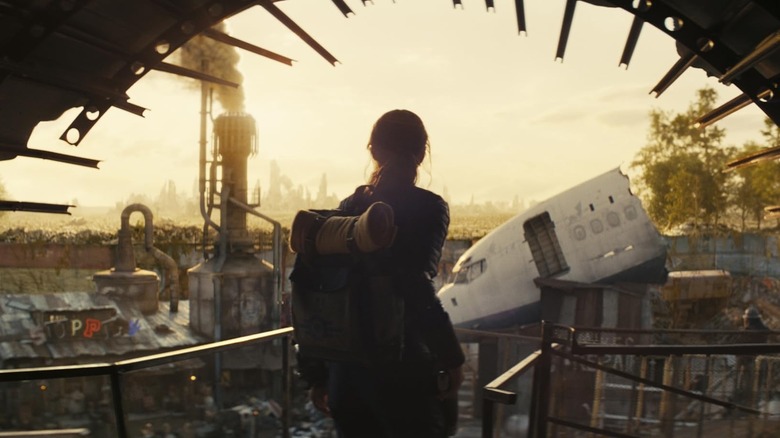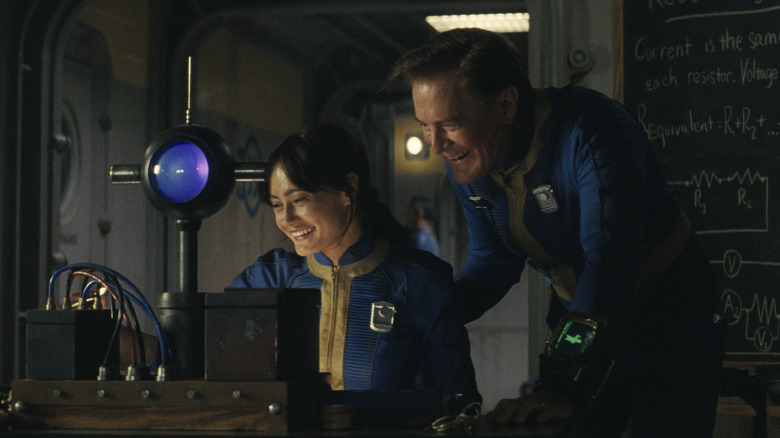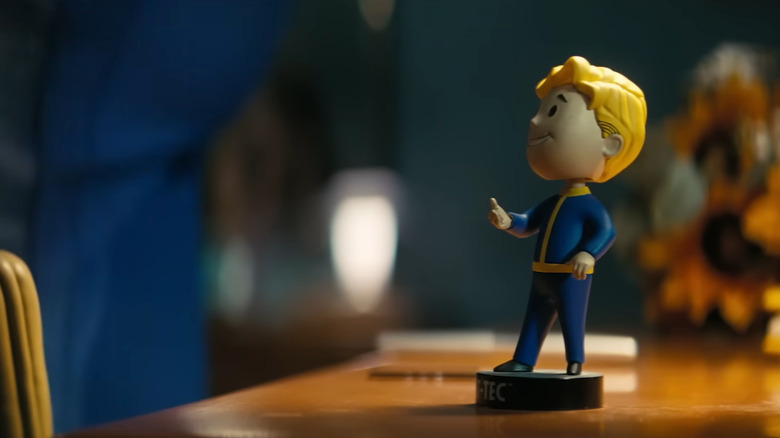Here's What The Fallout TV Series Doesn't Tell You About The Vaults
The "Fallout" video games (and now the TV show) are unique among stories set in the post-apocalypse for their grim comedy. Granted, you wouldn't notice at first glance. The franchise's wasteland is home to plenty of horrors like radroaches, radaxolotls with fingers for teeth, and the fearful deathclaw, while the "Fallout" TV adaptation is all about themes of privilege, prejudice, and inequality.
"Fallout," in other words, is not strictly a post-apocalyptic comedy like "Zombieland" and not exactly a hang-out story like "Zom 100: Bucket List Of The Dead." Still, there is plenty of joy to be found within its universe — as long as you live in a vault.
Vaults are as quintessential to the world of "Fallout" as ghouls or Power Armor. It is where you start each and every one of the main games, as well as the last safe haven on Earth before the nukes obliterated the surface. They are a paradise in the apocalypse, keeping people free of radiation and safe from the monsters roaming the wasteland. Plus, they have a pretty cool mascot, too!
Of course, that is only part of it. Like everything else when it comes to "Fallout," there is a lot more underneath the surface (no pun intended) and plenty that the games and show don't tell you.
A Vault-Tec product
As soon as the bombs dropped in the "Fallout" universe, a select number of people descended into survival shelters designed by the Vault-Tec Corporation — in partnership with the U.S. government — to escape the nuclear fallout that turned the planet into a wasteland where ghouls and mutants roam.
People inside survived free of radiation because the vaults were deep underground, with massive blast doors and tons of soil protecting the structures from the fallout. Neither the show nor the games specify the number of vaults, but there are just over 120 vaults in the games, each housing just a couple hundred survivors on average. We see this in the "Fallout" TV series, where Vault 33 appears to house just a few dozen people. Granted, this is over 200 years after the nuclear holocaust, and the show makes it clear there is a lot of incest happening, which isn't great for babies, but still, not a lot of survivors.
So how do a couple dozen people survive for centuries? Thankfully for them, Vault-Tec spared no expense when it came to equipping the vaults, which had their own water purification systems, agricultural farms, and even intranet with access to both entertainment and educational material to teach future generations. The one part of the system that did cause problems was the water chips, which failed in both the live-action show and "Fallout 2."
Otherwise, the vaults were pretty much as advertised, not needing much in terms of protection but relying on sealable heavy-duty doors and surveillance cameras — though we do see an armory in Vault 33. Ironically, the last safe haven for American capitalists after the war against communism ended up being a socialist utopia.
A false sense of security
One interesting thing about the "Fallout" TV show's portrayal of the vaults is that Vault 33 is connected to Vaults 32 and 31 through tunnels. This is not present in the games, but seems to echo something essential to the vaults — they are traps. You see, Vault-Tec may sell itself as the savior of humanity, but the corporation had a long history of corruption and mismanagement even before the bombs dropped. For instance, misuse of funds resulted in few vaults being commissioned, giving less than 0.1% of the population a chance to survive the apocalypse.
What's worse, Vault-Tec was really a front for the Enclave, a pre-war deep state with one mission — to leave the planet behind. That's right, according to original creator Tim Cain, the Enclave's plan was to create a multi-generational starship to leave Earth behind (as they assumed it would be uninhabitable after nuclear war) and settle on another planet.
Before they could do that, though, they would use the vaults as a way to conduct experiments, testing the occupants in different circumstances — usually horrible ones that ended in suffering and death. The simple truth is that the vaults are giant experiments, not utopias.
In the games, there is a vault where everyone got exposed to a virus and either died or became a super mutant; a vault filled with the world's greatest musicians who are subjected to stress-inducing white noise; a vault that sacrificed one of their own every year until they realized it was all for nothing; and even a vault full of orphans (their parents were executed as soon as they entered the vaults) trained to be super soldiers, only to have their genes "harvested" once they came of age. In short, don't trust the vault salesman.
The "Fallout" TV series is now streaming on Prime Video.


